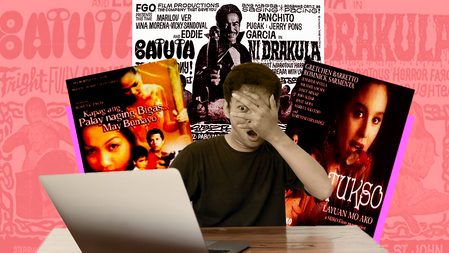SUMMARY
This is AI generated summarization, which may have errors. For context, always refer to the full article.

When film director Roman Perez Jr.’s team released the erotica film Adan, a dark romance between two lesbians, in 2018, it was met by a so-so crowd in the movie houses; ticket sales and audience impact did not exactly turn out the way Perez and his team had hoped for.
But when it found a different platform through the streaming app iFlix during the early months of the COVID-19 pandemic, Adan emerged as the No. 1 most viewed film on the streaming app for months.
“Streaming in the Philippines was the industry’s temporary solution to the COVID-19 pandemic. Movie houses were closed and Filipinos started to stay and work at home. To keep themselves occupied during quarantine, Netflix became the most popular site, with local producers licensing their library of movies to the streaming giant,” noted film critic Jojo De Vera.
The rapid growth of Netflix and iFlix during the early days of the pandemic gave birth to Filipino-produced streaming apps such as Vivamax, the over-the-top streaming service of Philippine media and entertainment Viva Communications Inc. that was launched in early 2021.
“Vivamax gained a steady stream of new followers in its first few weeks. But eventually, when we released Taya – a psychedelic erotic thriller that revolved around an online gamer who placed bets [on] a game in hopes to win his preferred prize: the woman of his dreams – Vivamax eventually reached millions of subscribers,” recalled Perez.
“Taya changed the dynamics of ‘streaming cinema,’” he added. “After we released Taya, we started seeing the deluge of new erotica films in streaming apps. Producers suddenly remembered that erotica is a vast landscape that has been forgotten in the past decade.”
The good ol’ days of Pinoy bold films
The popularity of erotica in the Philippines is not at all a new phenomenon. Long-time film buffs know that Filipinos have always been loyal to its flesh-baring films.
Such films started to gain popularity during the mid- to late ‘60s and ‘70s, during the time when they were called “bomba” or “bold” films because of their explosive character, which was so new to Filipino movie viewers at that time. “These were films that showed actual penetration similar to the ‘pene’ (short for “penetration”) films of the mid-’80s,” described De Vera.
Actresses of that generation starred and gained more popularity in bomba films, such as Merle Fernandez, Rosanna Ortiz, Alona Alegre, and Rosanna Marquez. It was also the genre that made stars out of Alma Moreno, Gloria Diaz, Rio Locsin, Claudia Zobel, and Stella Strada, to name a few.
According to De Vera, “Bold movies had more daring themes, as actresses would show their bare backs, or wear a wet white kamison or nightgown where you could almost see silhouettes of their naked bodies.”
In the ’90s, bold movies started to be called “TF” (titillating films) and served as tickets to fame for the likes of Gretchen Barretto, Priscilla Almeda, Christina Gonzales, and Rosanna Roces, all of whom eventually became household names. Film giants Regal, Viva, and Seiko benefited from making TF films.
It is wrong, however, to assume that such films were just “cinematic porn.” If anything, they served as a platform to spread a political message; filmmakers used bomba movies as a metaphor for social issues.
De Vera noted that if there was any common denominator among the most successful bomba films back in those days, aside from their flesh-baring character, it was that all of them were written by accomplished scriptwriters such as Ricky Lee, Joey Reyes, Pete Lacaba, and Lino Brocka, and directed by famed directors like Brocka, Chito Roño, William Pascual, and Tikoy Aguiluz.
As an illustration of bomba films’ political character, De Vera shared, “In Peque Gallaga’s Scorpio Nights, the entresuelo where the characters lived is the director’s vision of the Marcos government. Orestes Ojeda’s character is the law because he works as a security guard and is the only person in the community who owns a gun. He lords over everybody and treats his wife not as a person or woman but a mere sex object.”
The future of ‘bomba’ amid a woke climate
After the age of TF films in the ‘90s, it seemed as though bomba films entered into a quieter period through the new millennium. But for De Vera, “Bold films never died; they are still very much around. Even some action movies had obligatory sex scenes. This kind of movie will always have an audience.”
The fact that Vivamax became one of the most successful streaming sites is largely in part to bomba films, according to De Vera. “The actresses that star in their projects can barely act but they are more than willing to disrobe in front of the camera. The viewing public is responsible for the popularity of these films.”
But for today’s newer bomba films to enjoy longer popularity, they must go beyond mere sex.
“In the ’90s, directors were just bent on making TF films to make money for the producers. They were not as involved as Brocka or Bernal. That is probably the reason why TF was short-lived,” said De Vera.
He sees a similar trend in today’s bomba films. “They have a very little story; it is one sex scene after another.”
However, De Vera was quick to point out that there are some newer bomba films that deserve more credit. “There are some filmmakers who have shown that they are capable of making movies that matter. There is Roman Perez, whose remake of The Housemaid was a lot better than the original, and his Sitio Diablo was also very fiery and intense. There is also Lawrence Fajardo who directed the exhilaratingly great Reroute and the dark mystery Nerisa.”
While De Vera is confident that bomba films will always be around regardless of generation, he also believes that today’s bomba films can enjoy a more permanent niche if they are also as progressive as the society their viewers belong to.
He gives props to newer bomba films for, specifically, giving character development to the female leads.
“Before, women were passive and quiet; the men made the decisions and did the talking for them. But that did not mean that they would just stand there and do nothing; they may not be as vocal as today’s women, but they still fought for the right,” he recalled. But in today’s bomba films, “The female characters are more aware of their surroundings and their roles in society. Movies mirror today’s women. They are no longer victims. They are now portrayed as aggressive and sexual.”
Perez is aware of the feminist critics of bomba films. But in his defense, he said that most of their viewers are actually women.
“They idolize the likes of AJ Raval and Ayanna Misola – all of whom appear as female leads in our films. Why? Their characters are not perfect, and that is why our female audiences resonate with them and their courage and strength. They tell themselves, ‘We are alike. I would also like to be strong and confident about my womanhood, just like these characters.'”
This is why, according to Perez, women are already portrayed differently in today’s bomba films. “In these films, the women hold the power to control men. They use their bodies as their weapon.” – Rappler.com
Add a comment
How does this make you feel?







There are no comments yet. Add your comment to start the conversation.